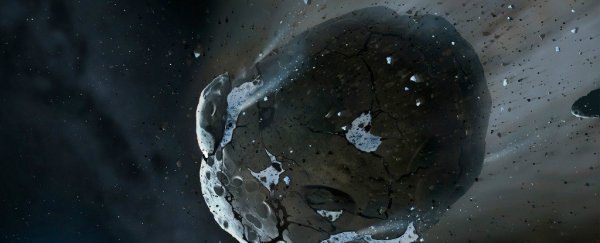According to some alarming tabloid headlines, three giant asteroids are skimming by Earth this weekend - one as long as a blue whale!
Here's what's really going on: there are a number of asteroids about to zip through Earth's general neighbourhood, according to a NASA asteroid watch website.
But we're not in any danger whatsoever - they're all at or well outside the Moon's orbit. Comfortingly, one has already safely passed by.
Asteroids are streaming past us every day, as a matter of fact, although many of them are too wee to be detectable, or even potentially hazardous.
However, NASA keeps an eye out for the bigger chunks of space rock, just in case.
According to NASA's official Near-Earth Asteroids categories, anything smaller than around 140 metres (460 feet) isn't considered potentially hazardous.
By those metrics, the four asteroids about to pass by this weekend are absolute shrimpazoids.
Here they are (all times in GMT):
- Asteroid 2018 VA2 will make its closest approach at 1:01 am GMT on Friday, 9 November at a distance of 718,070 kilometres (446,188 miles). It's 10 to 23 metres (33 to 75 feet) in diameter. Phew, missed us!
- Asteroid 2018 VS1 will make its closest approach at 2:03 pm on Saturday, 10 November at a distance of 1.39 million kilometres (865,418 miles). It's 13 to 28 metres (43 to 92 feet) in diameter.
- Asteroid 2018 VR1 will make its closest approach at 2:19 pm on Saturday, 10 November at a distance of 5.06 million kilometres (3.15 million miles). It's 14 to 30 metres (46 to 98 feet) in diameter.
- Asteroid 2018 VX1 will make its closest approach at 6:20 pm on Saturday, 10 November at a distance of 381,474 kilometres (237,037 miles). It's the closest, but the smallest, of all four, just skimming inside the Moon's average distance of 384,400 kilometres (238,855 miles), but only 7.9 to 18 metres (26 to 59 feet) in diameter.
Next week there are some much bigger asteroids zipping past as they orbit the Sun, with 2018 UQ1 boasting a diameter of 110 to 250 metres (361 to 820 feet), and 2017 UL12 at 180 to 390 metres (590 to 1,280 feet).
But these are much farther out, at 9 and 16 times the average distance to the Moon respectively. So, really, you don't need to panic.
Now, Earth's asteroid safety measures aren't necessarily the best. One might even say they're nonexistent. But NASA is working on it. The detection system is undergoing constant improvement, and in 2021, NASA engineers are going to test a new method of deflecting rocks away from Earth.
In the meantime, comfort yourself with the knowledge that, although asteroids wind up meeting Earth with relative frequency, most of the time no one gets hurt.
And all of next week's asteroids are going to sail harmlessly by, with no one but asteroid watchers even seeing them in the sky. If you have a telescope, maybe you can try to catch them yourself.
